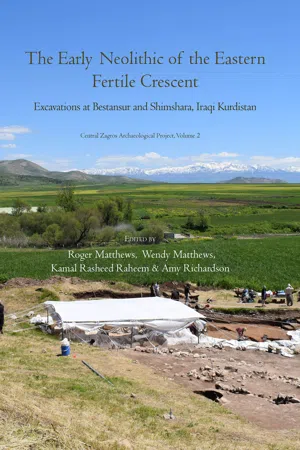
The Early Neolithic of the Eastern Fertile Crescent
Excavations at Bestansur and Shimshara, Iraqi Kurdistan
- 720 pages
- English
- ePUB (mobile friendly)
- Available on iOS & Android
The Early Neolithic of the Eastern Fertile Crescent
Excavations at Bestansur and Shimshara, Iraqi Kurdistan
About This Book
The Eastern Fertile Crescent region of western Iran and eastern Iraq hosted major developments in the transition from hunter-forager to farmer-herder lifestyles through the Early Neolithic period, 10, 000-7000 BC. Within the scope of the Central Zagros Archaeological Project, excavations have been conducted since 2012 at two Early Neolithic sites in the Kurdistan region of Iraq: Bestansur and Shimshara. Bestansur represents an early stage in the transition to sedentary, farming life, where the inhabitants pursued a mixed strategy of hunting, foraging, herding and cultivating, maximising the new opportunities afforded by the warmer, wetter climate of the Early Holocene. They also constructed substantial buildings of mudbrick, including a major building with a minimum of 65 human individuals, mainly infants, buried under its floor in association with hundreds of beads. These human remains provide new insights into mortuary practices, demography, diet and disease during the early stages of sedentarisation. The material culture of Bestansur and Shimshara is rich in imported items such as obsidian, carnelian and sea-shells, indicating the extent to which Early Neolithic communities were networked across the Eastern Fertile Crescent and beyond. This volume includes final reports by a large-scale interdisciplinary team on all aspects of the results from excavations at Bestansur and Shimshara, through application of state-of-the-art scientific techniques, methods and analyses. The net result is to re-emphasise the enormous significance of the Eastern Fertile Crescent in one of the most important episodes in human history: the Neolithic transition.
Frequently asked questions
Information
Table of contents
- Cover
- Title
- Copyright
- Contents
- Contributors
- Preface and Acknowledgements
- PART 1: INTRODUCTION: 1. The Neolithic transition in the Eastern Fertile Crescent: project themes, aims and objectives
- PART 2: ARCHAEOLOGICAL AND ENVIRONMENTAL FIELDWORK: 2. Excavation, recording and sampling methodologies
- 3. Palaeoclimate and environment of the Iraqi Central Zagros
- 4. Intensive field survey in the Zarzi Region
- 5. Fluxgate gradiometry survey at Bestansur
- 6. Geoarchaeological borehole, sediment and microfossil analyses at Bestansur
- 7. Ethnoarchaeological research in Bestansur: insights into vegetation, land-use, animals and animal dung
- 8. Conservation
- 9. Excavations and contextual analyses: Bestansur
- 10. Excavations and contextual analyses: Shimshara
- 11. Radiocarbon dating of Bestansur and Shimshara
- PART 3: MICRO-CONTEXTUAL AND BIOARCHAEOLOGICAL APPROACHES: 12. Sustainability of early sedentary agricultural communities: new insights from high-resolution microstratigraphic and micromorphological analyses
- 13. Integrated micro-analysis of the built environment and resource use: high-resolution microscopy and geochemical, mineralogical, phytolith and biomolecular approaches
- 14. Microarchaeology: the small traces of Neolithic activities
- 15. Animal remains and human-animal-environment relationships at Early Neolithic Bestansur and Shimshara
- 16. Early Neolithic animal management and ecology: integrated analysis of faecal material
- 17. Bestansur molluscs: regional context and local activities
- 18. The charred plant remains from Early Neolithic levels at Bestansur and Shimshara
- 19. Human remains from Bestansur: demography, diet and health
- PART 4: MATERIAL CULTURE AND COMMUNITY ARCHAEOLOGY: 20. Early Neolithic chipped stone worlds of Bestansur and Shimshara
- 21. Material culture and networks of Bestansur and Shimshara
- 22. Ground stone tools and technologies
- 23. Public archaeology at Bestansur
- PART 5: THEMATIC SYNTHESIS AND DISCUSSION: 24. The Neolithic transition in the Eastern Fertile Crescent: thematic synthesis and discussion
- Bibliography